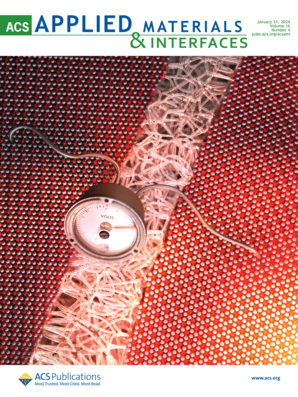Understanding the Role of the Zr-MOF Support Structure on Templated Ternary CO2 Hydrogenation Catalyst Structure and Activity.
IF 8.3
2区 材料科学
Q1 MATERIALS SCIENCE, MULTIDISCIPLINARY
引用次数: 0
Abstract
Depending on catalytic reaction conditions, metal-organic frameworks (MOFs) are excellent supports or templates for catalysts, owing to their ordered porous structures, large surface areas, and degree of thermal and chemical stability. Indeed, the structural diversity afforded (e.g., Zr-node density, pore size, and ligand stability) enables a high degree of control over the chemistry and structure of Zirconium MOF (Zr-MOF)-based or MOF-derived catalysts (MDCs). Here, we synthesize ternary CO2 hydrogenation catalysts from MOF-based precatalysts and examine the effect that the MOF structural features have on the CO2 hydrogenation catalyst structure and activity. This was achieved by preparing Cu/ZnO@Zr-MOF precatalysts with microporous (UiO-66) and mesoporous (MIP-206 and NU-1000) templates. It was found that the Cu/ZnO@Zr-MOF precatalysts underwent in situ structural transitions under reaction conditions that were temperature dependent. Microporous UiO-66 converts to small domains of ZrO2, with Cu dispersion (surface vs interior) dictated by the rate of support conversion at 200, 225, and 250 °C (Cu/ZnO@ZrO2). The mesoporous MOFs (MIP-206 and NU-1000) templated Cu nanoparticles with ZnO clusters on a ZrO2 support (Cu/ZnO@ZrO2) under mild reaction conditions (200/225 °C, 40 bar, 3:1/4:1 H2/CO2), but at higher temperatures, the less stable MIP-206 support converted to small crystalline domains of ZrO2 as well as templating Cu nanoparticles. Indeed, these MDCs displayed varied catalytic activity and selectivity, depending on the MOF template and formation temperature, most notably MIP-206- and UiO-66-based catalysts showing improved activity for methanol formation when prepared at higher temperatures (250 °C, 40 bar, 3:1 H2/CO2; but tested under milder conditions), whereas the NU-1000-derived catalysts gave reduced activity due to pore blockage and poor access to catalyst sites. Our results indicate that higher-performing catalysts can be accessed through careful selection of precursor Zr-MOF with appropriate structure metrics and judicious choice of in situ activation conditions.Zr-MOF载体结构对模板化三元CO2加氢催化剂结构和活性的影响
根据催化反应条件的不同,金属有机骨架(mof)由于其有序的多孔结构、大的表面积以及一定程度的热稳定性和化学稳定性,是催化剂的优秀载体或模板。事实上,所提供的结构多样性(例如,Zr-MOF节点密度、孔径和配体稳定性)使得对锆MOF (Zr-MOF)基或MOF衍生催化剂(MDCs)的化学和结构进行高度控制成为可能。本文以MOF基预催化剂为原料合成了三元CO2加氢催化剂,并考察了MOF结构特征对CO2加氢催化剂结构和活性的影响。这是通过制备微孔(UiO-66)和介孔(MIP-206和NU-1000)模板的Cu/ZnO@Zr-MOF预催化剂来实现的。结果表明,Cu/ZnO@Zr-MOF预催化剂在温度相关的反应条件下发生了原位结构转变。微孔uuo -66转化为小的ZrO2域,Cu分散(表面vs内部)取决于200、225和250°C时的载体转化率(Cu/ZnO@ZrO2)。在温和的反应条件下(200/225℃,40 bar, 3:1/4:1 H2/CO2),介孔mof (MIP-206和mu -1000)在ZrO2载体(Cu/ZnO@ZrO2)上用ZnO团簇模板化Cu纳米粒子,但在较高的温度下,不稳定的MIP-206载体转化为ZrO2的小晶域和模板化Cu纳米粒子。事实上,这些MDCs表现出不同的催化活性和选择性,取决于MOF模板和形成温度,最明显的是MIP-206和uio -66催化剂在较高温度下(250°C, 40 bar, 3:1 H2/CO2;但在较温和的条件下测试),而nu -1000衍生的催化剂由于孔隙堵塞和难以进入催化剂位点而活性降低。研究结果表明,通过精心选择具有适当结构指标的Zr-MOF前驱体和合理选择原位活化条件,可以获得性能更高的催化剂。
本文章由计算机程序翻译,如有差异,请以英文原文为准。
求助全文
约1分钟内获得全文
求助全文
来源期刊

ACS Applied Materials & Interfaces
工程技术-材料科学:综合
CiteScore
16.00
自引率
6.30%
发文量
4978
审稿时长
1.8 months
期刊介绍:
ACS Applied Materials & Interfaces is a leading interdisciplinary journal that brings together chemists, engineers, physicists, and biologists to explore the development and utilization of newly-discovered materials and interfacial processes for specific applications. Our journal has experienced remarkable growth since its establishment in 2009, both in terms of the number of articles published and the impact of the research showcased. We are proud to foster a truly global community, with the majority of published articles originating from outside the United States, reflecting the rapid growth of applied research worldwide.
 求助内容:
求助内容: 应助结果提醒方式:
应助结果提醒方式:


